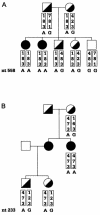Mutations in two genes encoding different subunits of a receptor signaling complex result in an identical disease phenotype
- PMID: 12080485
- PMCID: PMC379202
- DOI: 10.1086/342259
Mutations in two genes encoding different subunits of a receptor signaling complex result in an identical disease phenotype
Erratum in
- Am J Hum Genet. 2003 Jan;72(1):225.
Abstract
Polycystic lipomembranous osteodysplasia with sclerosing leukoencephalopathy (PLOSL), also known as "Nasu-Hakola disease," is a globally distributed recessively inherited disease leading to death during the 5th decade of life and is characterized by early-onset progressive dementia and bone cysts. Elsewhere, we have identified PLOSL mutations in TYROBP (DAP12), which codes for a membrane receptor component in natural-killer and myeloid cells, and also have identified genetic heterogeneity in PLOSL, with some patients carrying no mutations in TYROBP. Here we complete the molecular pathology of PLOSL by identifying TREM2 as the second PLOSL gene. TREM2 forms a receptor signaling complex with TYROBP and triggers activation of the immune responses in macrophages and dendritic cells. Patients with PLOSL have no defects in cell-mediated immunity, suggesting a remarkable capacity of the human immune system to compensate for the inactive TYROBP-mediated activation pathway. Our data imply that the TYROBP-mediated signaling pathway plays a significant role in human brain and bone tissue and provide an interesting example of how mutations in two different subunits of a multisubunit receptor complex result in an identical human disease phenotype.
Figures




References
Electronic-Database Information
-
- Ensembl Human, http://www.ensembl.org/Homo_sapiens/
-
- GenBank, http://www.ncbi.nlm.nih.gov/Genbank/index.html (for TREM2 cDNA [accession number BF343916], TYROBP cDNA [accession number AA481924], and ACTB cDNA [accession number X00351])
-
- GeneTests–GeneClinics, http://www.geneclinics.org/ (for PLOSL)
-
- Online Mendelian Inheritance in Man (OMIM), http://www.ncbi.nlm.nih.gov/Omim/ (for PLOSL [MIM 221770])
-
- UCSC Human Genome Project Working Draft, http://genome.ucsc.edu/ (for UCSC Human Genome Browser)
References
-
- Bird TD, Koerker RM, Leaird BJ, Vlcek BW, Thorning DR (1983) Lipomembranous polycystic osteodysplasia (brain, bone, and fat disease): a genetic cause of presenile dementia. Neurology 33:81–86 - PubMed
-
- Bouchon A, Dietrich J, Colonna M (2000) Cutting edge: inflammatory responses can be triggered by TREM-1, a novel receptor expressed on neutrophils and monocytes. J Immunol 164:4991–4995 - PubMed
-
- Bouchon A, Facchetti F, Weigand MA, Colonna M (2001a) TREM-1 amplifies inflammation and is a crucial mediator of septic shock. Nature 410:1103–1107 - PubMed
Publication types
MeSH terms
Substances
Associated data
- Actions
- Actions
- Actions
- Actions
LinkOut - more resources
Full Text Sources
Other Literature Sources
Medical
Molecular Biology Databases

